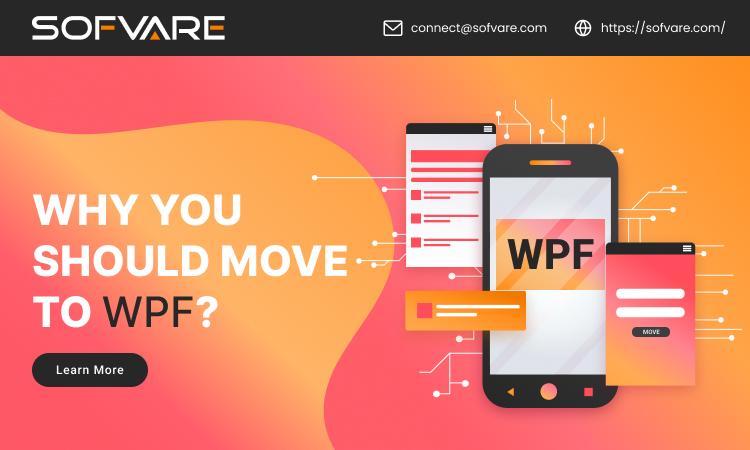Why Should You Move to WPF?
Have you switched to Windows Presentation Foundation (WPF) yet? If yes, wow. You made a winning move. However, if not, read on to find out what WPF is and its benefits.
Windows Presentation Foundation: The Definition
It is an open-source development framework known for its free-of-cost graphical subsystem like WinForms. Previously called Avalon, WPF was introduced by Microsoft with the aim of rendering user interfaces in various Window-oriented applications.
Initially, Windows Presentation Foundation was launched in 2006 as a component of .NET Framework 3.0. It utilizes DirectX and intends to deliver a consistent and uniform programming platform for developing apps.
WPF differentiates UI from domain or business logic and mimics XML-based object models, including the ones used in SVG (Scalable Vector Graphics) and XUL (XML User Interface Language).
Some of the best features of WPF Application Development include the following – XAML (Extensible Application Markup Language), data binding, animation, controls, layout, templates, styles, documents, 2D and 3D graphics, typography, text, and media, to name a few.
Are you looking for reliable WPF Application Development Services to deliver an immersive experience to your customers? Choose a service provider that creates certified applications in line with the latest industry standards.
XAML is the Core of WFP
In WPF, everything is put in XAML (an XML-centric language). So, the components of the user interface, including combo boxes, text boxes, radio buttons, and other elements, are explained in XAML.
Developers also used this mark-up language to define how various styles should be put forth with the components. Styles play a crucial role in controlling aspects like height, width, color, etc. Simply put, XAML, a.k.a., Silverlight, is the tomorrow for RIA (Rich Internet Applications) and desktop development. Also, using this language is likely to decrease the length of code developers ought to write.
Changing Styles and Themes is a Cakewalk with WFP
As far as modifying the feel and look of a usual Windows Forms application is concerned, it requires tons of rework and good association between the designer and the programmer. Right? WPF is an exit from the standard. With WFP, the programmer may work on the basic controls in a random manner and make the code get going. Then, the designer may shuffle the entire controls without making any changes to the back-end code.
Moreover, with WFP, you can change the feel and look of an application without the need to recompile the code. It would be no easy feat with a typical Windows Forms application. Isn’t it?
Seamless Isolation of Business Logic and UI
Microsoft created WFP to combine business or domain logic and presentations easily. When developing an app, you may make use of design conventions, such as Model View View Model (MVVM) or Model View Controller (MVC). These design methods allow you to separate your domain logic from the user interface. Moreover, these help you unit test each and every line of the code you wrote in the app. Although Windows Forms also lets you isolate logic and UI, with WPF the process has become seamless.
Incorporate Animation With No Room for Hassle
Although animation is hardly needed for most business applications, a well-made animation (brief) may grab the attention of your users. It may help your users to become aware of something on their screens that may miss otherwise. Most importantly, applications with animation are self-documenting and offer more user-friendliness. And with WPF, animations are no Herculean tasks.
Windows Presentation Foundation (WPF): The Highlights
• Enjoy limitless flexibility and possibilities when building your own UI
• Offers scalability at its best in a multi-resolution environment
• Reuse the codes
• Use controls with robust data-binding powers
• Impeccable support from Microsoft
• Add animations and special effects to UI components on the screen
• Direct2D for flawless 2D and 3D display
• Enhancement of the visual experience of the users
So, now that you know about the plus points of WPF, do you need more reasons to move to the dynamic world of immense possibilities?
Outsourcing WPF Application Development Services: The Benefits
Here are the few reasons why outsourcing your WPF Application Development Services is always a wise thing to do. Let’s take a look:
• Experienced and reliable service providers understand the potential of having a WPF-based application for your company. They can help you get applications that are visually appealing
• Top-notch companies make use of state-of-the-art technologies that live up to the expectations of their clients. They ensure compatibility at its best by tailoring the apps to client needs.
• Partnering with a reputable WPF Development service provider can help you cater to your customer’s needs in the best possible way. Choose a company that’s licensed and trustworthy.
• Always join forces with a company that works with your team right from conceptualization and planning to design, QA, and maintenance. Transparency is a benchmark of reliability, after all.
Be informed and choose the best service provider for outstanding WPF Application Development.

